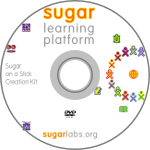Homepage | Activities | Events | Lists | Development | Translate | Contact
Difference between revisions of "Downloads"
m |
|||
| Line 13: | Line 13: | ||
* If you have a high-speed Internet connection,<br>'''Fedora with the Sugar graphical learning environment''' may be installed to a hard disk or a a 4 GB USB stick [[Sugar_Creation_Kit/sck/netinstall|with a '''Netinstall CD''']]. | * If you have a high-speed Internet connection,<br>'''Fedora with the Sugar graphical learning environment''' may be installed to a hard disk or a a 4 GB USB stick [[Sugar_Creation_Kit/sck/netinstall|with a '''Netinstall CD''']]. | ||
:- Not a compressed LiveOS image like SoaS, but all of Sugar. | :- Not a compressed LiveOS image like SoaS, but all of Sugar. | ||
| − | :- {{Highlight|bgcolor= | + | :- {{Highlight|bgcolor=#f9f6b7|''This requires a high-speed Internet connection for software component downloading during installation.''}} |
---- | ---- | ||
| Line 66: | Line 66: | ||
# '''Prepare''': These instructions are only for '''64-bit''' processor machines. (To identify the processor type, choose Apple menu > About This Mac. A small window will appear titled ''About This Mac''. The processor type is displayed in this window. Sugar on a Stick is for the Intel processor only.)<br><br> | # '''Prepare''': These instructions are only for '''64-bit''' processor machines. (To identify the processor type, choose Apple menu > About This Mac. A small window will appear titled ''About This Mac''. The processor type is displayed in this window. Sugar on a Stick is for the Intel processor only.)<br><br> | ||
# '''Download''' the latest [[Sugar on a Stick/Downloads | Sugar on a Stick]] .iso file. Be sure to download a '''64-bit''' image. [http://download.sugarlabs.org/soas/releases/ (older versions)]<br><br> | # '''Download''' the latest [[Sugar on a Stick/Downloads | Sugar on a Stick]] .iso file. Be sure to download a '''64-bit''' image. [http://download.sugarlabs.org/soas/releases/ (older versions)]<br><br> | ||
| − | # '''Load''': <span style="background-color:#f9f6b7 | + | # '''Load''': <span style="background-color:#f9f6b7; padding: 10px; padding-left: 5px;">[[File:question.png|link=|middle]] '''Help: Does someone have a simple way to load a Live USB on a Mac?'''</span><br>Here is a simple way to recognize a bootable USB on a Mac.<br>Go to rEFIt (http://refit.sourceforge.net/) and make a bootable cd. There is no need to install rEFIt on your mac. In fact installing rEFIt may make it impossible to upgrade the Mac OS to a newer version later on (personal experience, I had to do a clean install). Put the rEFIt CD in and hold the option key after turning the computer on. The Mac will recognize the CD because it uses EFI and then the CD will recognize the bootable USB.<br> |
#* [http://refit.sourceforge.net/doc/c1s5_burning.html How to Burn a rEFIt CD] | #* [http://refit.sourceforge.net/doc/c1s5_burning.html How to Burn a rEFIt CD] | ||
#: You can rename the .cdr file to .iso for use in GNU/Linux. | #: You can rename the .cdr file to .iso for use in GNU/Linux. | ||
Revision as of 02:11, 25 January 2012
| <imagemap>
File:Download-circle.png rect 58 6 109 51 MS Windows rect 146 28 195 85 GNU/Linux rect 146 128 200 181 OLPC XO rect 60 154 111 212 virtual machine rect 5 77 50 133 Apple Mac OS X rect 86 76 128 133 Are you new to Sugar? desc none </imagemap> |
|
Are you new to Sugar?
The quickest download is Sugar on a Stick, (SoaS). Basic instructions are found below.
- Once you download, and then burn or load an SoaS .iso file, and boot it, the running Fedora-16 SoaS Live CD/USB may be used to install Sugar to a hard disk or to a 4 GB USB stick with the
liveinstcommand.
- - You start with a SoaS LiveOS image, and then load an uncompressed version onto the hard disk or USB stick.
- - The Fedora-16-Live-SoaS.iso file is a 443 MB download.
- If you have a high-speed Internet connection,
Fedora with the Sugar graphical learning environment may be installed to a hard disk or a a 4 GB USB stick with a Netinstall CD.
- - Not a compressed LiveOS image like SoaS, but all of Sugar.
- -
Sugar on a Stick installation instructions
MS Windows
|
|
|
Detailed installation instructions for Windows and booting instructions are available. There is also a guide to exploring Sugar.
GNU/Linux

|
|
Detailed installation instructions for GNU/Linux and booting instructions are available. There is also a guide to exploring Sugar. GNU/Linux users may also want to install the Sugar packages on their favorite distro, apart from Sugar on a Stick.
Apple Mac OS X
DRAFT: These instructions are incomplete. Please help with testing and documentation. In the meantime, we recommend the Virtual Machines instructions below.
|
|
Alternative installation instructions for Mac OS X. Also, these older installation instructions and booting instructions may be consulted.
There is also a guide to exploring Sugar.
Advanced users
Do you have an OLPC XO?

|
|
Do you use GNU/Linux?
Select your favorite distribution Community/Distributions |
| |||||||||||||||||
| Or try a Live USB version of Sugar | or, for brave pioneers, v7 beta with Sugar 0.95 and Fedora 17 (Beefy Miracle) |
Are you a developer?

|
Learn how to get setup on the Supported systems page.
Some additional references you may find useful:
|
Virtual Machines on all platforms
VirtualBox Appliances | |
|
|
If you run into problems, you may want to consult the Talk:VirtualBox page for help.
Are you preparing a deployment without Internet access?
| See Sugar Creation Kit |
Are you looking for Sugar Activities?
| Visit the Sugar Activity Library | <imagemap>
File:Sugarlabs_mainpage_02.png rect 14 14 38 47 Calculate rect 74 15 107 44 Chat rect 137 16 171 43 Implode rect 201 14 238 46 Distance rect 265 12 298 47 Etoys rect 11 79 41 108 Moon rect 74 78 106 110 Paint rect 140 78 170 109 Pippy rect 201 80 235 108 Read rect 266 82 298 107 Record rect 11 143 41 172 TamTam Synth Lab rect 75 146 105 169 Terminal rect 142 140 166 173 Turtle Blocks rect 201 144 235 171 WikiBrowse rect 269 142 299 173 Write default Sugar Activity Library desc none </imagemap> |




